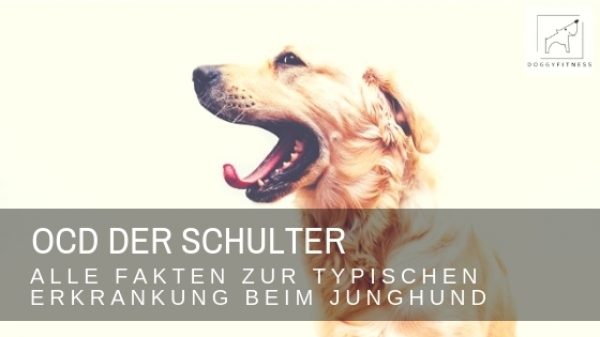OCD of the shoulder – typical disease in young dogs
In this article, I’ll tell you how OCD develops. You will learn how to recognize it in a dog and what it means for him. In addition, it is about how you can avoid and treat them.
OCD is a joint disease in young dogs. This means it usually occurs between 4 and 8 months of age. Most often, the shoulder joint is affected. Rarely, the knee, elbow and ankle are affected. The joints that are particularly stressed are always affected.
What is the composition of the shoulder joint?
It consists of the shoulder blade and upper arm. The two shoulder blades rest against the side of the chest wall. They are connected to the thorax only by large muscle cords. The scapula has a slightly triangular shape and is a flat bone. Its tip is angled downward. You can easily feel the edges of the scapula on your dog. The downward pointing tip forms a socket. The head of the humerus fits in there. Together they form the shoulder joint. The shoulder joint is a so-called ball and socket joint. This means that a cup-shaped joint socket encompasses a spherical joint head. There are taut ligaments that run along the inside and outside of the joint. They only allow flexion and extension. Movement to the left or right is only minimally possible.
How does OCD develop?
In the young dog, the skeleton does not consist entirely of bone, but still of the soft cartilaginous tissue. During growth, cartilage cells are gradually replaced by bone cells. On the one hand, ossification strengthens the skeleton. On the other hand, it ensures the nutrition and oxygen supply of both bone and cartilage cells. There are various triggers that lead to disturbances in ossification during growth.
What happens?
In the process, the cartilage increases irregularly in thickness. The cartilage and bone mass underneath are no longer adequately supplied. They die off. When a major stress occurs, the cartilage tears. The joint fluid penetrates into the resulting gap. It prevents the broken piece of cartilage from healing again. Such a free piece of cartilage is called “corpora libre”. It swims around freely in the joint. It also prevents full movement. In the movement it triggers pain. At the same time arthrosis develops, which is fatal in the young dog’s life.
Which dogs are affected? What are triggers for OCD?
There are breeds that have a genetic predisposition to be affected. These breeds include, for example, German Shepherd, Golden Retriever and Great Danes. But Rottweiler, Labrador and Bernese tendon dogs are also affected. All breeds have in common that they can reach a weight of 25kg and more as adult dogs. Male dogs are affected more frequently than female dogs. Additionally, excessive activity in young dogs and obesity promote OCD. Too fast growth due to too high energy feed is also a factor. In addition, excessive administration of minerals and vitamins promotes OCD. Of course, it can also result from an accident or fall.
What are the consequences?
Osteoarthritis develops, which progresses more and more. Your dog loses muscle. Tension develops in the heavily stressed areas due to the relieving posture.
What are the symptoms for OCD?
The first symptoms usually appear between the 4th and 8th month of life. The dogs show lameness mostly after exertion. You turn the affected leg outward and press the upper arm against the body. The joint is heated and swollen. Especially the bending and stretching of the barrel is painful. The stride length is shortened and the mobility of the run is limited. Affected dogs avoid jumps. They lose muscle in the affected front leg. Tension forms as a result of the relieving posture and overloading.
How is OCD diagnosed?
The first clues for the diagnosis are age and symptoms. By means of an X-ray, the OCD can become visible.
How to treat them?
In mild OCD without free cartilage particles, conservative therapy may be attempted. This means by means of anti-inflammatory and pain-relieving drugs. Accompanied by strict leash restrictions. In the case of detached cartilage parts, it makes sense to remove them surgically. The sooner this is done, the more likely it is that the formation of arthritis can be prevented or kept at a low level. With physiotherapy you relieve the dog’s pain. It helps to release tension, as well as restore mobility in the shoulder joint. The musculature is also rebuilt and a normal sequence of movements is trained. These measures are useful after surgical removal of the bone and cartilage parts. But even with treatment without surgery, you should not do without it.
How do you avoid OCD?
When your dog is young, he should and is allowed to exercise. But make sure he doesn’t overexert himself. Running on the bike overloads the dog. Avoid jumps, abrupt stops and tight turns. Make sure to feed them in a way that is appropriate for their age. Avoid food that is too high in energy. You should always keep an eye on your dog’s weight. This is how you prevent joint damage.
You want to become active yourself and do something for the fitness and health of your four-legged friend? Then take a look at my ONLINE VIDEO COURSES! There is guaranteed the right course for you and your dog!
Dieser Beitrag ist auch verfügbar auf:
Français (French)
Deutsch (German)
Español (Spanish)















